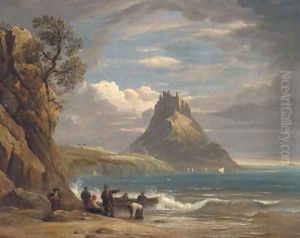John Snr Varley Paintings
John Varley was an influential English watercolourist and a founding member of the Old Watercolour Society, known today as the Royal Watercolour Society. Born on August 17, 1778, in Hackney, London, Varley was part of a large family. His early interest in art was nurtured by his father, Richard Varley, a postmaster and amateur artist. Despite the financial difficulties his family faced, Varley managed to pursue his passion for art, initially apprenticing with a portrait painter named Joseph Charles Barrow.
Varley's career in art took a significant turn when he started studying under the landscape painter Thomas Hearne, whose influence can be seen in Varley's meticulous and detailed landscapes. In 1805, Varley exhibited at the Royal Academy for the first time, marking the beginning of a long and successful career as an artist. He became a key figure in the London art scene, not only as an artist but also as a teacher. Among his pupils were significant figures such as David Cox, Copley Fielding, and John Linnell, who would later become his brother-in-law. Varley's teaching extended beyond traditional methods; he was known for his innovative use of watercolours, contributing to the medium's growing popularity in England.
Varley's work was characterized by its atmospheric effects and romantic landscapes, often inspired by his travels throughout Britain. His fascination with the sublime and the picturesque was evident in his paintings, which frequently depicted dramatic skies and expansive views. In 1804, Varley was among the founders of the Watercolour Society, an institution that played a crucial role in elevating the status of watercolour as a serious art form. Through his involvement, he helped to organize exhibitions that showcased the versatility and beauty of watercolour paintings.
Despite his contributions to art and his success as a teacher, Varley's life was marked by financial instability. He was known to have moved frequently, often in an attempt to evade creditors. His interests were not limited to art; Varley was deeply involved in astrology, which influenced not only his personal beliefs but also his artistic work. He published a book on astrology and made astrological predictions, including one for the poet William Blake, a close friend.
John Varley died on November 17, 1842, leaving behind a legacy that had a lasting impact on the development of British watercolour painting. His works continue to be celebrated for their beauty and technical skill, and his role in founding the Old Watercolour Society cements his place as a pivotal figure in the history of British art.
